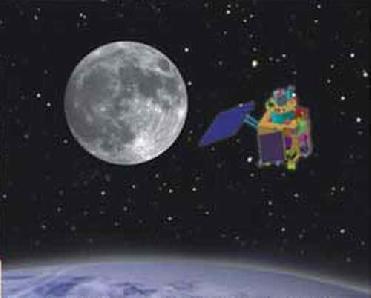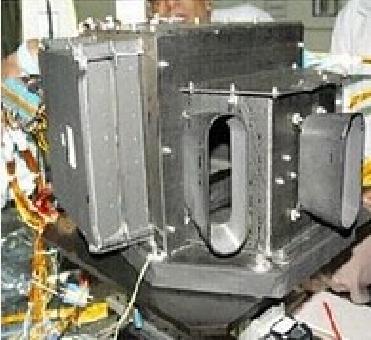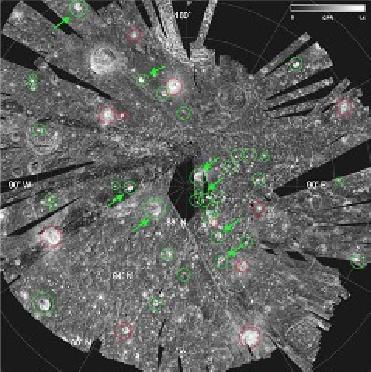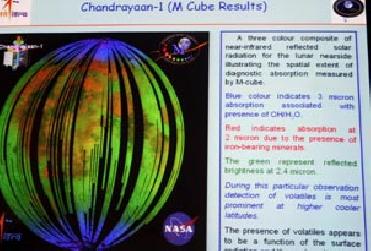
Illustration of Chandrayaan in orbit. ISRO
BANGALORE (PTI): During the various phases of its flight, Chandrayaan-1 spacecraft will send detailed information about its health to the Earth through its transmitter, according to Indian Space Research Organisation (ISRO).
At the same time, the spacecraft will be ready to receive radio commands sent from Chandrayaan-1 spacecraft control centre instructing it to perform various tasks. Besides, the spacecraft receives, modifies and retransmits radio waves sent by ground antennas in a precise way. This plays a crucial role in knowing its position and orbit at a particular time. All these happen at 'S-band' frequencies in the microwave region of the electromagnetic spectrum.
Additionally, as it orbits the Moon, the spacecraft sends valuable imagery and other scientific information to Earth through X-band (at a higher frequency compared to S-band), which also lies in the microwave region.
But, such information is transmitted through radio at a very low power of a few Watts. Thus, radio signals carrying that precious information become extremely feeble by the time they travel 400,000 km from the Moon and reach the Earth.
The ground segment of Chandrayaan-1 performs the crucial task of receiving the radio signals sent by the spacecraft. It also transmits the radio commands to be sent to the spacecraft during different phases of its mission. Besides, it processes and safe keeps the scientific information sent by the spacecraft.
ISRO Telemetry, Tracking and Command Network (ISTRAC) had a lead role in establishing the ground segment facility of Chandrayaan-1 along with ISRO Satellite Centre (ISAC) and Space Applications Centre (SAC). The ground segment of Chandrayaan-1 consists of Indian Deep Spacer Network (IDSN), Spacecraft Control Centre (SCC) and Indian Space Science Data Centre (ISSDC).
The IDSN performs the important task of receiving the radio signals transmitted by the spacecraft that become incredibly feeble by the time they reach the Earth. Besides, it can send commands to the spacecraft at a power level of up to 20 kw.
IDSN consists of two large parabolic antennas, one with 18m and the other 32m diameter at Byalalu, situated at a distance of about 35 km from Bangalore. Of these, the 32m antenna with its 'seven mirror beam waveguide system' is indigenously designed, developed, built, installed, tested and qualified.
The 18m antenna can support Chandrayaan-1 mission, but the 32m antenna can support Chandrayaan-1 and any spacecraft mission further deep into space.
During the initial phase of the mission, besides these two antennas, other ground stations of ISTRAC Network at Lucknow, Sriharikota, Bangalore, Thiruvananthapuram, Port Blair, Mauritius, Brunei, Biak (Indonesia) and Bearslake (Russia) as well as external network stations at Goldstone, Applied Physics Laboratory in Maryland, Hawaii (all three in USA), Brazil and Russia support the mission.
The Spacecraft Control Centre, located near ISTRAC campus at Peenya, north of Bangalore, is the focal point of all the operational activities of Chandrayaan-1, during all the phases of the mission. Commands to be transmitted to Chandrayaan-1 spacecraft to maintain its health as well as to make it perform various tasks originate from here. Experts specialising in various spacecraft subsystems as well as spacecraft mission operations personnel will be available at SCC.
ISSDC receives (from IDSN as well as other external stations that support Chandrayaan-1) stores, processes, systematically archives, retrieves and distributes the precious scientific information sent by Chandrayaan-1 cameras, spectrometers and other scientific instruments from the lunar orbit.
It has state-of-the-art computers and data storage devices. The ISSDC is also located at Byalalu.














The Indian Air Force, in its flight trials evaluation report submitted before the Defence Ministry l..
view articleAn insight into the Medium Multi-Role Combat Aircraft competition...
view articleSky enthusiasts can now spot the International Space Station (ISS) commanded by Indian-American astr..
view article